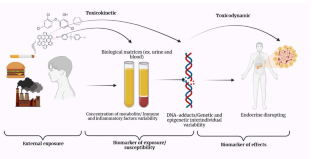Biomarkers of susceptibility are indicative of an individual’s capacity to react to particular exposures, whereas toxicodynamic models elucidate the correlation between exposure and response. In this article, a novel methodology is presented for the evaluation of modifying factors in the field of toxicology. The proposed approach involves the integration of biomarkers of susceptibility with toxicodynamic models. Through the integration of these two methodologies, scientists are able to gain a more comprehensive understanding of the impact of modifying factors, such as genetic polymorphisms or epigenetic profiles, on an individual’s reaction to toxic substances. This methodology has the potential to facilitate a more thorough evaluation of the hazards linked to the contact with combinations of chemicals and the cumulative effects of such exposures. The utilization of biomarkers in the evaluation of exposure for risk assessment is progressively incorporating the examination of susceptibility factors alongside exposure factors. This may involve the identification of a particular genetic polymorphism for a metabolic enzyme. The integration of ecotoxicological tests with models is crucial for achieving a comprehensive assessment. This approach exhibits the potential to enhance our comprehension of disease causation and facilitate the identification of populations that may exhibit an elevated susceptibility to disease.



